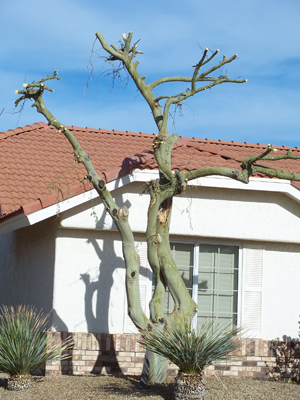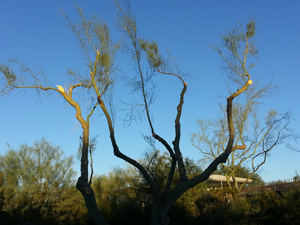Pruning Made Easy: What to Do and What NOT to Do
 04 January 2017
04 January 2017 

How to prune, What to prune and when to prune
Pruning trees in Arizona -- particularly in desert areas – is a little like remodeling your house. It’s complicated and takes some planning, and you don’t know if you will like the finished product until the job is done.
According to ISA certified arborist, John Eisenhower, homeowners can be confused about whether trees need to be trimmed or cut, crowned or rounded or whatever. That’s why they often end up with trees that look scalped or strange once the job is done; and, sometimes the so-called pruning can endanger a tree’s health. Eisenhower, owner of Integrity Tree Service of Phoenix, is a regular guest on “Rosie on the House,” our Saturday morning radio program.
So here are five basics he suggests homeowners may want to remember when pruning or hiring someone else to prune trees.

1 | Terminology Speaks Volumes
Use the right terms in contracting for tree services: Workers will sometimes talk about trimming, cutting, topping, rounding, crowning, lacing or shearing. None of that really explains what workers will actually do, Eisenhower says. Better to ask for pruning that will provide crown cleaning, thinning, raising, reducing and restoring. If you’d like to learn more, check out pruning standards drawn up by the American National Standards Institute.
2 | No Topping or "Lion's Tailing"
Never allow topping or “lion’s tailing” to be done on your trees! These two techniques are among the worst procedures ever used on trees and can lead to many new and serious problems (the pictures in this post are examples of these bad procedures).
Topping usually occurs when trees grow taller and spread out. Maybe branches hit the house or hang over the roof. At that point, people start cutting through large stems at the top of trees or at ends of large branches. That topping can encourage lots of sprouting at the ends of the branches that have been cut. It can also create a dense foliage shell that blocks normal sunlight for smaller branches inside the tree. And the big cuts can leave wounds that can allow fungi to invade the tree.
During “lion’s tailing,” the interior branches of a tree is over-pruned, leaving behind long slender limbs with a puff of foliage at the end that looks something like the tail of a lion. This technique can lead to profuse sprouting and weakened branches that break during storms. The trunk of the tree can be burned by the sun on super-hot days.
3 | There is a Right and Wrong Time of Year
You may have to prune each tree at a different time of year based on the kind of tree it is: December through February, for example, are the months to prune deciduous trees. You can also prune apples, peaches, nectarines, apricots, pomegranates, and nuts to dictate the height of the fruit-bearing branches. In other words, there are ways to keep the peaches from growing so tall that it is hard to reach the fruit at harvest time. Citrus trees need to be pruned after mid-February to avoid frost damage.
4 | Be Sensitive to Your Sensitive Trees
For sun-sensitive and frost-sensitive trees, reduce the percentage of foliage you remove: During the middle of winter and summer, avoid pruning altogether or do it only lightly to shape these trees. Citrus trees never require heaving pruning. Ideally branches should be allowed to grow down to the ground to shade the thin citrus bark from the sun.
5 | Desert Trees are Different
Pruning desert trees differs from pruning other types of trees: Pruning them is often best done in shoulder seasons, like spring and fall. Spring pruning will help avoid storm damage during summertime monsoons, of course. You may want to trim a branch or two after monsoons end. If you prune in the fall as tree growth slows down, the tree will hold its shape until next year.
Many homeowners would like to get bushy looking mesquites and palo verdes to grow taller, so they want to strip out lower branches to force growth at the top of the tree. But be very careful. When you prevent a tree from developing a full canopy, you reduce its capacity to photosynthesize and stay healthy. So be more relaxed about pruning desert trees in their early years.
Learn More Here!
Pruning Trees | Reasons, When, Techniques, etc.
Pruning Shrubs in the Low and Mid-Elevation Deserts in Arizona | UofA Cooperative Extension
Tree
Training
Cue
Car | Urban Tree Foundation
- Downloadable Cue Cards
- Planting Details and Specifications
- Arizona Landscape Contractors Association: Training/Study Materials
Outdoor Living Home Maintenance To-Do | #PruningYourTrees
###
Podcast
Sarah Maitland and Gary Peterson of SavATree are joined by Liberty Wildlife's Laura Hackett. Discussing the Tree Of The Month: the Chinese Evergreen Pear. We also discuss how improper pruning and cutting can affect a tree's health. We tackle proper pruning tips for trees and shrubs to promote spring grown and protect nesting birds this time of year. Laura talks about Liberty Wildlife's rehabilitation of Arizona wildlife from the smallest birds to the biggest owls.
Photo Credits:
RELATED CONTENT:
- Citrus: When is the best time to prune?
- Palo Verde: What's causing the browning on the branches?
- Cold Weather: How can I protect my plants and cactus from freezing?
- Frost Sensitive: Plants that Freeze and will NOT come back
- Find trusted Arizona contractors and home improvement service providers
Print this page
recent post
- Duck, Duck, Duct! How Often Should Ductwork Be Cleaned?
- Vinyl vs. Fiberglass Windows: Which Is The Better Choice Of Replacement Window?
- We May Be The Grand Canyon State, But The Rocky Mountains Are Important For Arizona
- Welcome to Arizona! Things A Newbie to Arizona Should Know
- The Pros & Cons of Buying A Flipped House
- Getting In On The Ground Floor
- Why It’s More Critical Than Ever To Get Your AC Serviced Before Summer
- The Reality of Remodeling
- What To Look For When Comparing Your Roofing Quotes
- What To Expect When Buying New Windows & Doors
